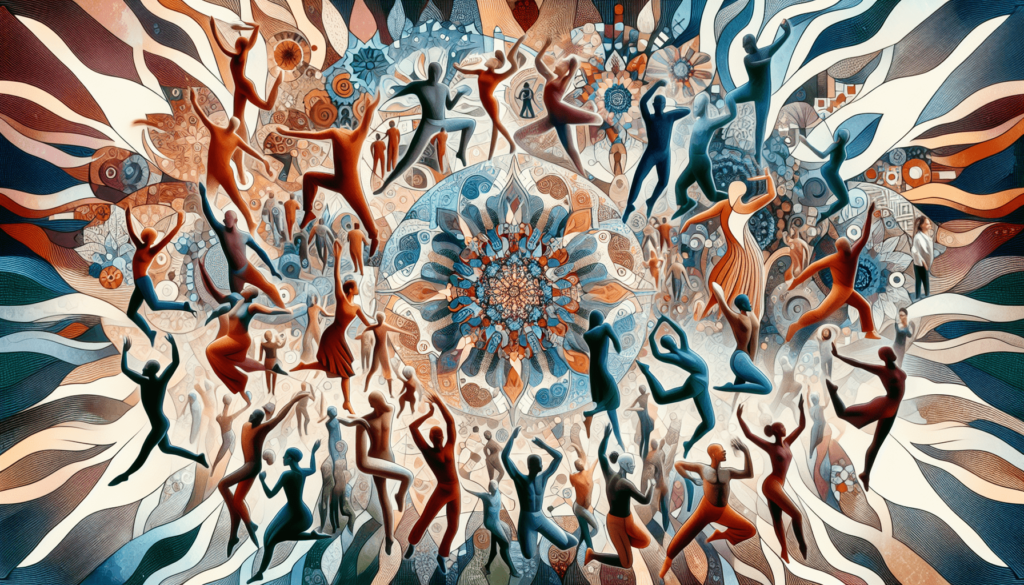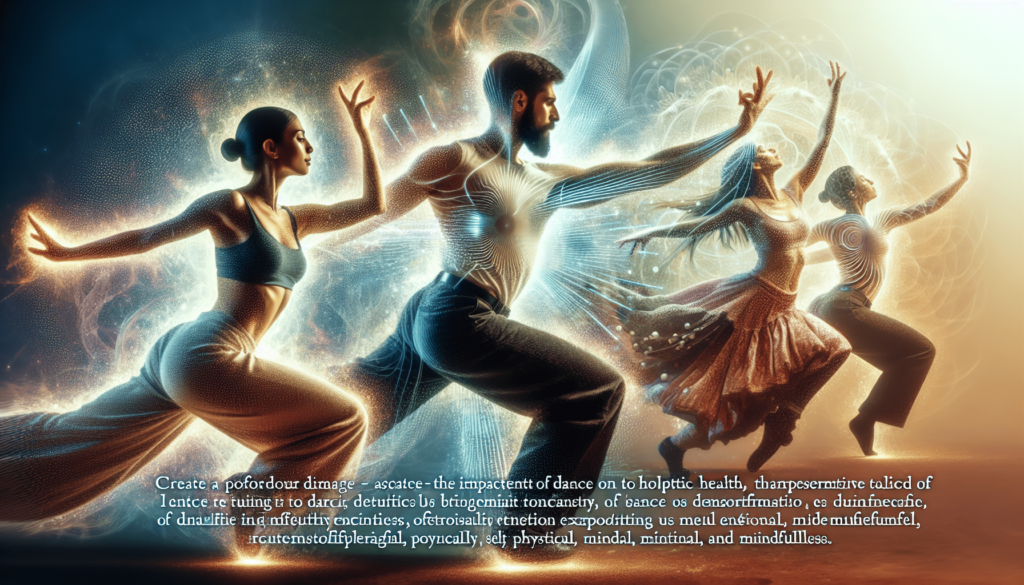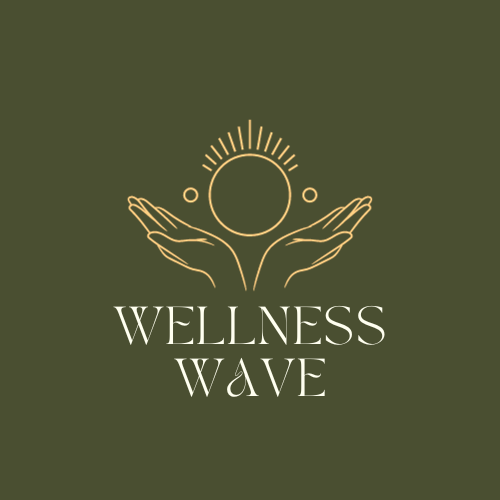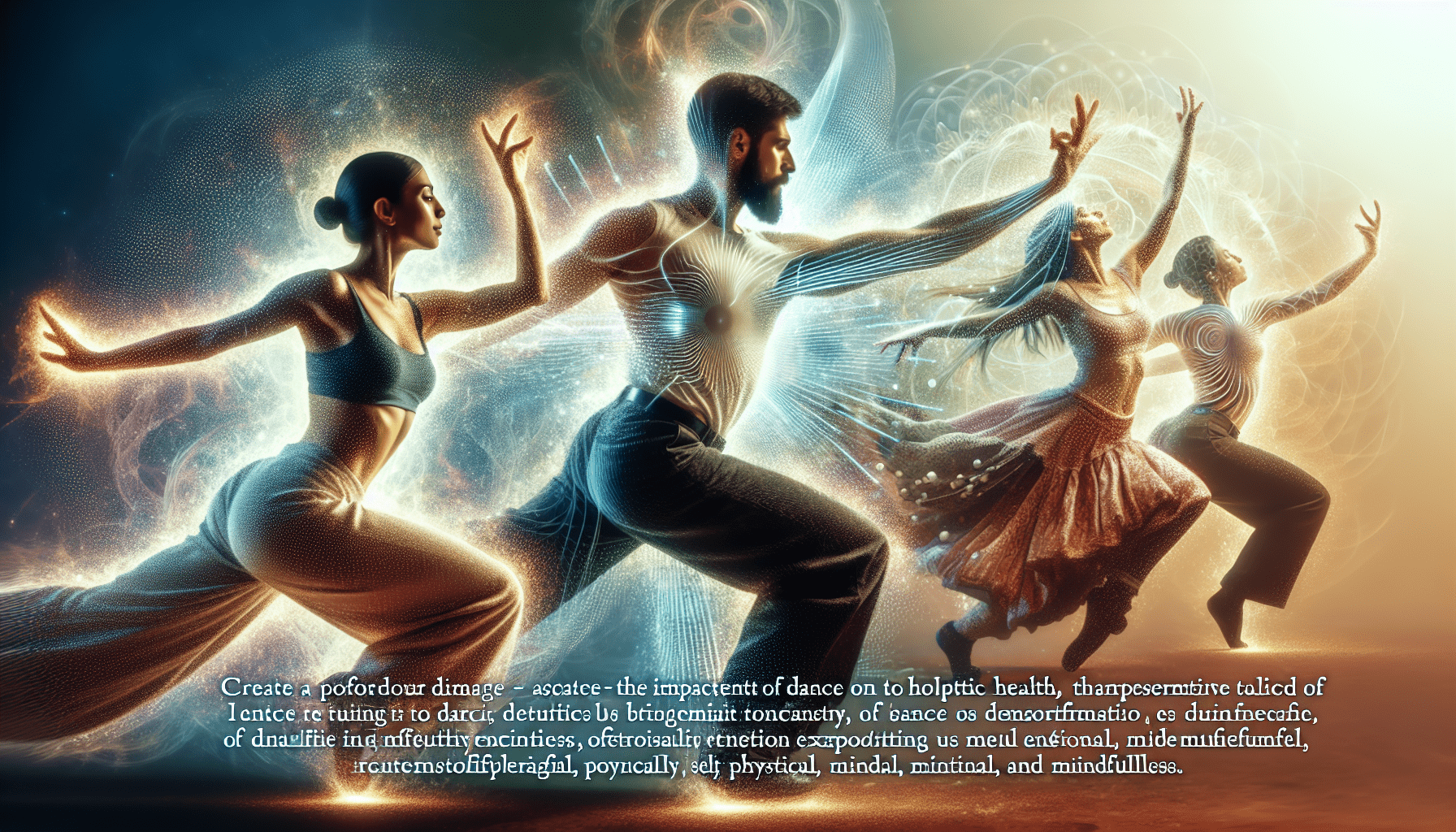In today’s fast-paced world, it’s easy to get caught up in the chaos and neglect our own well-being. However, there’s an ancient practice that holds the key to a healthier and more balanced life – dance. This article explores the powerful impact of dance on our overall well-being, highlighting its ability to promote physical fitness, mental wellness, and emotional resilience. So, if you’re looking for a fun and engaging way to prioritize your holistic health, it’s time to put on your dancing shoes and embark on a mindful movement journey.

Introduction
The growing interest in holistic health practices
In recent years, there has been a significant increase in people seeking out holistic health practices to improve their overall well-being. These practices focus on treating the whole person, addressing the physical, emotional, and mental aspects of health. As individuals become more aware of the importance of a balanced and harmonious lifestyle, they are turning to various methods to achieve this goal. One area that has gained considerable attention is the connection between mindfulness and movement, specifically the role of dance in promoting holistic health.
The connection between mindfulness and movement
Mindfulness, the practice of being fully present and engaged in the current moment, has long been recognized for its many benefits, including stress reduction, increased focus, and emotional well-being. When combined with movement, it becomes a powerful tool for promoting overall health and wellness. Dance, with its focus on bodily awareness, rhythmic expression, and intentional movement, perfectly aligns with the principles of mindfulness. By immersing yourself in the dance experience, you can cultivate mindfulness and reap the numerous benefits it offers.
Understanding Dance as Mindful Movement
The definition of mindful movement
Mindful movement refers to any physical activity that is performed with a conscious awareness of the body, breath, and sensations. It involves bringing your full attention to each movement, being present in the moment, and observing without judgment. Mindful movement can include a wide range of activities, such as yoga, tai chi, and of course, dance. It is an opportunity to connect with your body, engage your senses, and experience the joy of movement in a mindful way.
How dance can be a form of mindful movement
Dance, in its essence, embodies the principles of mindful movement. When you dance, you become attuned to the sensations in your body, the rhythm of the music, and the space around you. Every step, gesture, and expression is a deliberate act of mindfulness. Whether you are practicing a choreographed routine or simply moving freely to the music, dance encourages you to be fully present and aware of your body’s movements. Through dance, you can cultivate a deep sense of mindfulness, allowing you to experience the benefits of both physical activity and mindfulness.
The Physical Benefits of Dance
Improving cardiovascular health
Dance is an excellent form of aerobic exercise that gets your heart rate up and increases blood circulation. The continuous movement and varied intensity levels associated with different dance styles help improve cardiovascular health and strengthen your heart. Regular dance practice can lead to increased stamina, endurance, and a healthier cardiovascular system overall.
Building strength and endurance
Dance involves a range of movements that challenge various muscle groups, helping to build strength and endurance. Whether it’s the controlled movements of ballet, the powerful leaps of contemporary dance, or the quick footwork of salsa, dance requires strength and stamina to execute the steps with precision and grace. Through regular dance practice, you can tone and strengthen your muscles, improving overall physical fitness.
Enhancing flexibility and balance
Flexibility and balance are essential components of physical health and well-being. Dance, with its emphasis on stretching, reaching, and maintaining proper alignment, helps improve flexibility and increase range of motion. Additionally, dance requires a strong sense of balance and spatial awareness, which is continuously challenged and developed through various movements and positions. By incorporating dance into your holistic health practices, you can enhance your flexibility, balance, and overall physical performance.
The Emotional and Mental Benefits of Dance
Stress reduction and relaxation
Dance provides an excellent outlet for stress and tension release. As you immerse yourself in dance, focusing on the present moment, the worries and stress of daily life fade away. The rhythmic movements and the joy of expressing yourself through dance can induce a state of relaxation and calmness. Dance can serve as a form of therapy, enabling you to let go of negative emotions and recharge your mind and body.
Boosting mood and self-esteem
Engaging in dance can have a profoundly positive impact on your mood and self-esteem. The physical activity stimulates the release of endorphins, also known as “feel-good” hormones, which can elevate your mood and create a sense of happiness and well-being. Furthermore, the sense of accomplishment that comes from learning new dance moves, mastering a routine, or performing on stage can significantly boost self-confidence and self-esteem. Dance allows you to discover your capabilities and embrace your unique expression, improving your overall emotional well-being.
Fostering creativity and self-expression
Dance is a powerful form of artistic self-expression. It allows you to communicate your thoughts, emotions, and experiences without the need for words. Through dance, you can tap into your creative potential, explore different movements, and express your individuality. Dance offers a unique medium for self-expression, enabling you to connect with your inner emotions and share your story with others. By incorporating dance into your holistic health practices, you can nurture your creativity and enhance your overall emotional and mental well-being.

The Social Benefits of Dance
Promoting social connections and community
Dance is an inherently social activity that brings people together. Whether you’re participating in group classes, joining a dance team, or attending social dance events, dance provides ample opportunities for social connections and community engagement. Dancing with others creates a sense of camaraderie and fosters a supportive environment. It allows you to meet like-minded individuals, form new friendships, and become part of a vibrant community centered around a shared passion for dance.
Supporting teamwork and cooperation
Many dance styles, such as ballroom or group performances, require coordination and collaboration with others. By participating in partner or group dances, you develop essential skills of teamwork and cooperation. Dancing with others involves synchronized movements, clear communication, and trust-building, which are all vital elements of effective collaboration. Through dance, you can cultivate these skills while experiencing the joy of moving in unison with others.
Creating a sense of belonging
Dance has the power to create a sense of belonging and acceptance. In a world where people often feel isolated or disconnected, dance brings individuals together, creating a space where everyone is encouraged to express themselves freely. Whether you are a beginner or an experienced dancer, there is a place for you in the dance community. The sense of belonging that comes from being part of a dance group or attending dance events can have a profoundly positive impact on your overall well-being.
Dance as a Therapeutic Tool
Dance therapy and its applications
Dance therapy, also known as dance movement therapy, is a form of expressive therapy that uses movement and dance to promote emotional, cognitive, and physical healing. It is based on the belief that the body and mind are interconnected, and through integrating movement, emotions, and expression, individuals can achieve greater well-being and self-awareness. Dance therapy is used in various settings, including hospitals, mental health facilities, and rehabilitation centers, to address a wide range of conditions and promote holistic healing.
Using dance to address mental health conditions
Dance has been found to be an effective therapeutic tool for addressing various mental health conditions, including anxiety, depression, and PTSD. By engaging in dance, individuals are provided with a positive outlet for self-expression and a means to process and release emotions. The physical activity of dance stimulates the release of endorphins, which can improve mood and reduce symptoms of depression and anxiety. Dance also promotes self-awareness, mindfulness, and relaxation, which can be particularly beneficial in managing stress and trauma-related symptoms.
Dance as an outlet for emotional release
Dance offers a unique opportunity for emotional release. Through movement and expression, dance allows individuals to explore and release pent-up emotions, stress, and tension. In many cultures, dance has been used as a form of ritualistic healing and a way to connect with the deeper aspects of oneself. Whether it’s through improvisation or following a choreographed routine, dance provides a safe and non-verbal space for emotional release and transformation.
Dance Styles and Their Holistic Health Benefits
Ballet: Grace, discipline, and body awareness
Ballet, with its emphasis on grace, precision, and discipline, offers a multitude of holistic health benefits. The rigorous training and repetitive movements build strength, flexibility, and endurance. Ballet requires impeccable body awareness, control, and alignment, fostering a strong mind-body connection. Beyond the physical aspects, ballet instills a sense of artistry, poise, and self-discipline, which can extend beyond the dance studio and positively impact other areas of life.
Contemporary dance: Freedom of expression and creativity
Contemporary dance, with its emphasis on freedom of movement and self-expression, is a powerful form of holistic health practice. It allows dancers to explore and express their unique creativity, pushing the boundaries of traditional dance forms. Contemporary dance incorporates elements of various dance styles, encouraging dancers to tap into their individuality and embrace their authentic selves. Through contemporary dance, individuals can cultivate a deep sense of self-expression, creativity, and personal growth.
Salsa: Cardiovascular fitness and social interaction
Salsa, a popular Latin dance style, offers a perfect combination of physical exercise and social interaction. With its energetic movements and fast-paced rhythms, salsa provides an excellent cardiovascular workout, helping to improve stamina, endurance, and overall fitness. Salsa is often danced with a partner, promoting social connections and fostering a sense of community. The joy of dancing together, feeling the music, and connecting with others through movement creates a positive and uplifting experience that contributes to holistic health.
Incorporating Dance into Holistic Health Practices
Finding dance classes and workshops
To incorporate dance into your holistic health practices, start by exploring local dance studios, community centers, or recreational facilities that offer dance classes. Look for beginner-friendly classes or workshops that align with your interests and fitness level. Give yourself permission to try different dance styles and instructors until you find the ones that resonate with you. Dance classes provide guidance, structure, and a supportive environment to start or continue your dance journey.
Creating a home dance practice
In addition to taking classes, consider creating a home dance practice to supplement your studio or group sessions. Designate a space in your home where you can move freely and play your favorite music. Experiment with different dance styles, explore improvisation, or work on perfecting choreography from your classes. Dancing at home allows you to connect with your body and express yourself without any external pressures or expectations.
Integrating dance with other holistic practices
Dance can be seamlessly integrated with other holistic health practices to create a comprehensive wellness routine. Consider incorporating dance into your meditation practice by moving mindfully and connecting with your breath. Combine dance with yoga or tai chi to enhance body awareness and movement flow. Explore dance as a form of creative self-care, using it as a way to express and process emotions. By weaving dance into other holistic practices, you can experience a more holistic and well-rounded approach to health and wellness.
Tips for Mindful Dancing
Cultivating body awareness during movement
To practice mindful dancing, begin by cultivating body awareness. Before you start dancing, take a few moments to tune in to your body. Close your eyes, take a deep breath, and notice any sensations, tensions, or areas of ease in your body. Throughout your dance practice, continuously bring your attention to the physical sensations, noticing the contact of your feet with the ground, the movement of your limbs through space, and the rhythm of your breath. Cultivating body awareness will deepen your connection to the present moment and enhance your overall mindful dance experience.
Connecting with the music and rhythm
Music and rhythm are integral elements of dance. To enhance your mindful dance practice, focus on connecting with the music and allowing it to guide your movement. Close your eyes, listen deeply, and let the music move through you. Feel the beat, the melody, and the emotion it evokes. Allow the music to inspire your movement, encouraging you to explore different rhythms, dynamics, and expressions. By surrendering to the music, you can tap into a deeper level of connection and mindfulness in your dance.
Allowing for spontaneous and intuitive expression
Mindful dancing is not just about executing precise movements or following specific choreography; it is about allowing for spontaneous and intuitive expression. Let go of self-judgment and expectations, and instead, surrender to the present moment and trust your body’s innate wisdom. Allow your body to move freely, exploring the range of movements that feel natural and authentic to you. Let your intuition guide your dance, embracing the joy of self-expression and spontaneity. By giving yourself permission to dance without constraints, you can experience the transformative power of mindful movement.
Conclusion
The transformative power of dance in holistic health
Dance is a transformative practice that can bring tremendous benefits to our physical, emotional, and mental well-being. Through mindful movement, dance allows us to connect with our bodies, access our creative potential, and nurture our holistic health. It offers a space for self-expression, personal growth, and community engagement. By embracing dance as a holistic health practice, we can experience the joy, healing, and transformative power it holds.
Encouraging individuals to embrace mindful movement through dance
As we continue to explore various avenues for improving our overall well-being, it is crucial to consider the role of dance in promoting mindful movement and holistic health. Whether through ballet, contemporary dance, salsa, or any other dance style, we can tap into the power of dance to cultivate mindfulness, enhance physical fitness, and nurture our emotional and mental well-being. Let us embrace the transformative potential of dance and invite others to join us on this journey towards mindful movement and holistic health.

